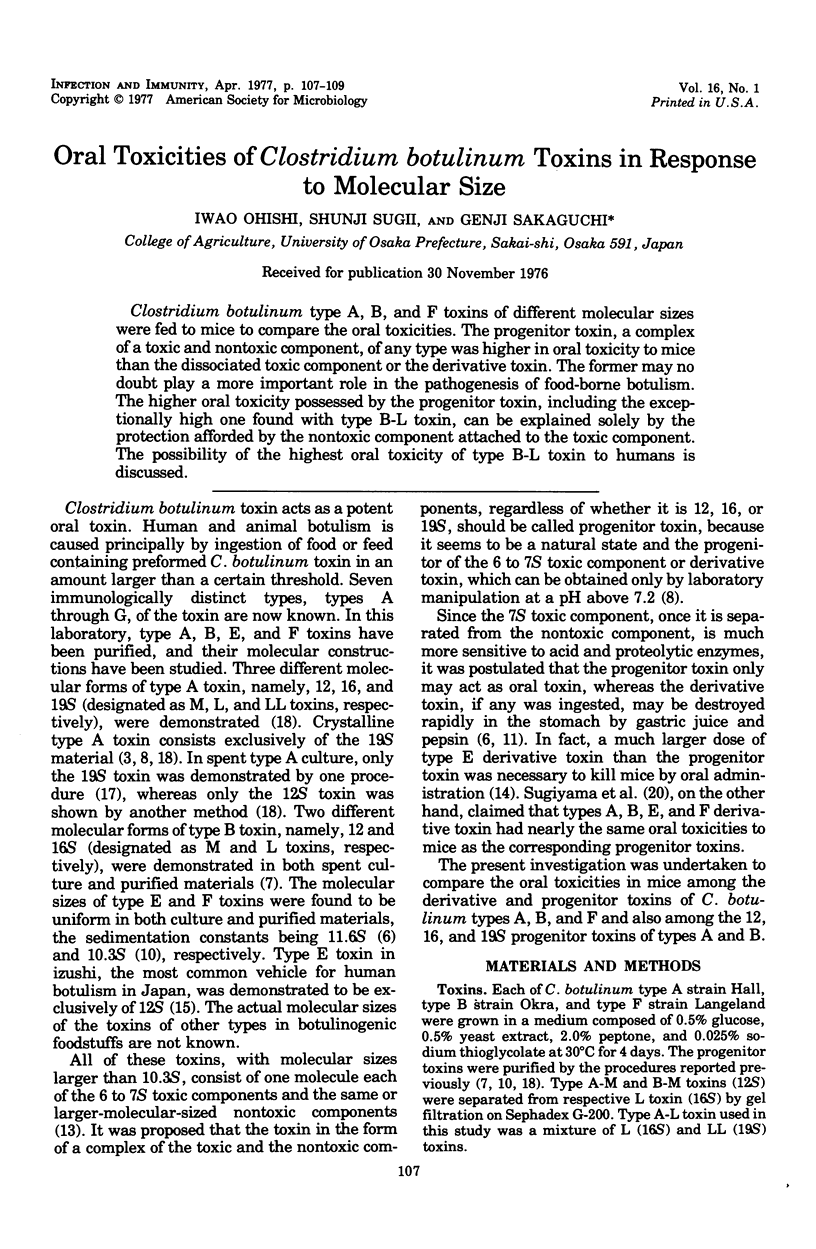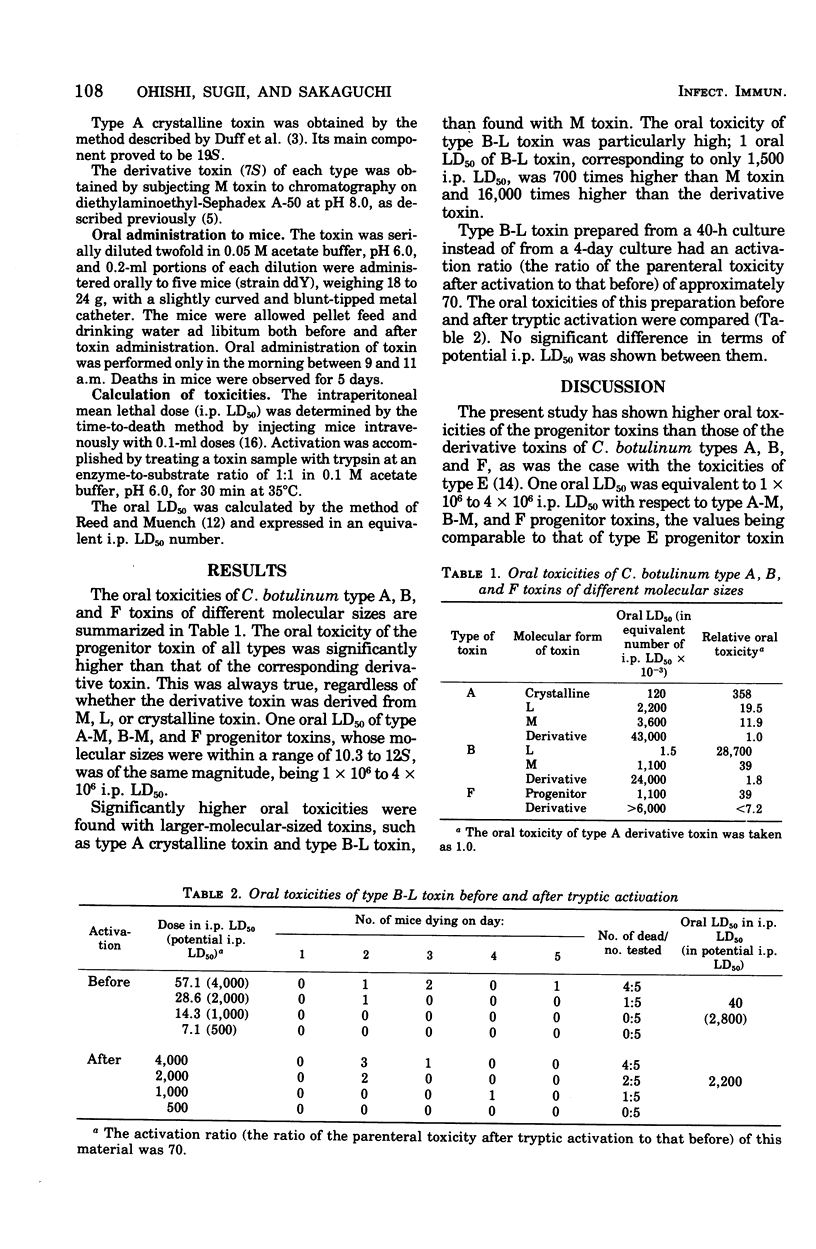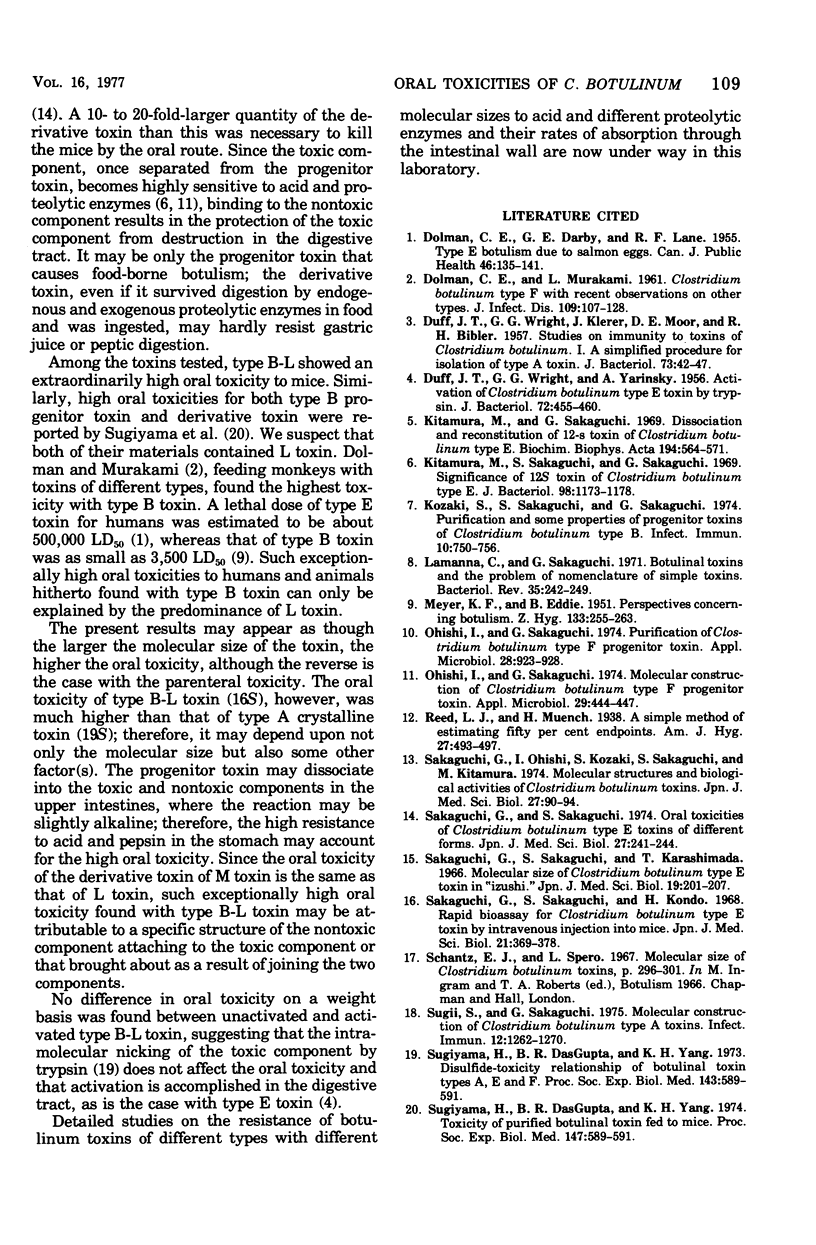Abstract
Clostridium botulinum type A, B, and F toxins of different molecular sizes were fed to mice to compare the oral toxicities. The progenitor toxin, a complex of a toxic and nontoxic component, of any type was higher in oral toxicity to mice than the dissociated toxic component or the derivative toxin. The former may no doubt play a more important role in the pathogenesis of food-borne botulism. The higher oral toxicity possessed by the progenitor toxin, including the exceptionally high one found with type B-L toxin, can be explained solely by the protection afforded by the nontoxic component attached to the toxic component. The possibility of the highest oral toxicity of type B-L toxin to humans is discussed.
Full text
PDF


Selected References
These references are in PubMed. This may not be the complete list of references from this article.
- DOLMAN C. E., DARBY G. E., LANE R. F. Type E botulism due to salmon eggs. Can J Public Health. 1955 Apr;46(4):135–141. [PubMed] [Google Scholar]
- DUFF J. T., WRIGHT G. G., KLERER J., MOORE D. E., BIBLER R. H. Studies on immunity to toxins of Clostridium botulinum. I. A simplified procedure for isolation of type A toxin. J Bacteriol. 1957 Jan;73(1):42–47. doi: 10.1128/jb.73.1.42-47.1957. [DOI] [PMC free article] [PubMed] [Google Scholar]
- DUFF J. T., WRIGHT G. G., YARINSKY A. Activation of Clostridium botulinum type E toxin by trypsin. J Bacteriol. 1956 Oct;72(4):455–460. doi: 10.1128/jb.72.4.455-460.1956. [DOI] [PMC free article] [PubMed] [Google Scholar]
- Kitamura M., Sakaguchi G. Dissociation and reconstitution of 12-S toxin of Clostridium botulinum type E. Biochim Biophys Acta. 1969 Dec 23;194(2):564–571. doi: 10.1016/0005-2795(69)90118-4. [DOI] [PubMed] [Google Scholar]
- Kitamura M., Sakaguchi S., Sakaguchi G. Significance of 12S toxin of Clostridium botulinum type E. J Bacteriol. 1969 Jun;98(3):1173–1178. doi: 10.1128/jb.98.3.1173-1178.1969. [DOI] [PMC free article] [PubMed] [Google Scholar]
- Kozaki S., Sakaguchi S., Sakaguchi G. Purification and some properties of progenitor toxins of Clostridium botulinum type B. Infect Immun. 1974 Oct;10(4):750–756. doi: 10.1128/iai.10.4.750-756.1974. [DOI] [PMC free article] [PubMed] [Google Scholar]
- Lamanna C., Sakaguchi G. Botulinal toxins and the problem of nomenclature of simple toxins. Bacteriol Rev. 1971 Sep;35(3):242–249. doi: 10.1128/br.35.3.242-249.1971. [DOI] [PMC free article] [PubMed] [Google Scholar]
- MEYER K. F., EDDIE B. Perspectives concerning botulism. Z Hyg Infektionskr. 1951;133(4):255–263. doi: 10.1007/BF02149050. [DOI] [PubMed] [Google Scholar]
- Ohishi I., Sakaguchi G. Molecular construction of Clostridium botulinum type F progenitor toxin. Appl Microbiol. 1975 Apr;29(4):444–447. doi: 10.1128/am.29.4.444-447.1975. [DOI] [PMC free article] [PubMed] [Google Scholar]
- Oishi I., Sakaguchi G. Purification of Clostridium botuliunum type F progenitor toxin. Appl Microbiol. 1974 Dec;28(6):923–928. doi: 10.1128/am.28.6.923-928.1974. [DOI] [PMC free article] [PubMed] [Google Scholar]
- Sakaguchi G., Sakaguchi S., Karashimada T. Molecular size of Clostridium botulinum type E toxin in "izushi". Jpn J Med Sci Biol. 1966 Aug;19(4):201–207. [PubMed] [Google Scholar]
- Sakaguchi G., Sakaguchi S., Kondo H. Rapid bioassay for Clostridium botulinum type-E toxins by intravenous injection into mice. Jpn J Med Sci Biol. 1968 Dec;21(6):369–378. doi: 10.7883/yoken1952.21.369. [DOI] [PubMed] [Google Scholar]
- Sakaguchi G., Sakaguchi S. Oral toxicities of Clostridium botulinum type E toxins of different forms. Jpn J Med Sci Biol. 1974 Aug;27(4):241–244. doi: 10.7883/yoken1952.27.241. [DOI] [PubMed] [Google Scholar]
- Sugii S., Sakaguchi G. Molecular construction of Clostridium botulinum type A toxins. Infect Immun. 1975 Dec;12(6):1262–1270. doi: 10.1128/iai.12.6.1262-1270.1975. [DOI] [PMC free article] [PubMed] [Google Scholar]
- Sugiyama H., Das Gupta R., Yang K. H. Disulfide-toxicity relationship of botulinal toxin types A, E, and F. Proc Soc Exp Biol Med. 1973 Jul;143(3):589–591. doi: 10.3181/00379727-143-37372. [DOI] [PubMed] [Google Scholar]
- Sugiyama H., DasGupta B. R., Yang K. H. Toxicity of purified botulinal toxin fed to mice. Proc Soc Exp Biol Med. 1974 Nov;147(2):589–591. doi: 10.3181/00379727-147-38394. [DOI] [PubMed] [Google Scholar]


